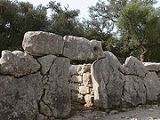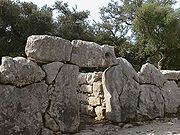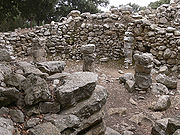
Ses Païsses
Encyclopedia

Bronze Age
The Bronze Age is a period characterized by the use of copper and its alloy bronze as the chief hard materials in the manufacture of some implements and weapons. Chronologically, it stands between the Stone Age and Iron Age...
talayotic settlement on the southeastern outskirts of Artà
Artà
Artà is one of the 53 independent municipalities on the Spanish Balearic island of Majorca. The small town of the same name is the administrative seat of this municipality in the region of Llevant.- Population :...
in northwestern Majorca. It is one of the most important and best-preserved prehistoric sites in the Balearic Islands
Balearic Islands
The Balearic Islands are an archipelago of Spain in the western Mediterranean Sea, near the eastern coast of the Iberian Peninsula.The four largest islands are: Majorca, Minorca, Ibiza and Formentera. The archipelago forms an autonomous community and a province of Spain with Palma as the capital...
, although it is largely overgrown with woodland, mainly Quercus ilex (holm oak), making it impossible to see the site as a whole.
Definition
The talaiotTalaiot
The talaiots, or talayots, are Bronze Age megaliths on the islands of Minorca and Majorca forming part of the Talaiotic Culture or Talaiotic Period. They date from the late second millennium and early first millennium BC. There are at least 274 of them, in, near, or related to Talaiotic settlements...
s, or talayots, are Bronze Age
Bronze Age
The Bronze Age is a period characterized by the use of copper and its alloy bronze as the chief hard materials in the manufacture of some implements and weapons. Chronologically, it stands between the Stone Age and Iron Age...
megalith
Megalith
A megalith is a large stone that has been used to construct a structure or monument, either alone or together with other stones. Megalithic describes structures made of such large stones, utilizing an interlocking system without the use of mortar or cement.The word 'megalith' comes from the Ancient...
ic structures on the islands of Minorca
Minorca
Min Orca or Menorca is one of the Balearic Islands located in the Mediterranean Sea belonging to Spain. It takes its name from being smaller than the nearby island of Majorca....
and Majorca. There are at least 274 of them. Dating from the late second millennium and early first millennium BC (between 1,300–900BC), they are round or square structures built of rough stone, around a central space at the center of which stood a column. This supported a ceiling of stone slabs which also formed the floor of the next story. Their purpose is not clearly understood: religious or tribal ceremonies, storehouses and distribution centres have been suggested. They are not thought to have been used as dwelling places or as defensive buildings.
These monuments pre-date the taula
Taula
A taula is a T-shaped stone monument found on the Balearic island of Minorca. Taulas can be up to 3.7 metres high and consist of a vertical pillar with a horizontal stone lying on it...
s, which are usually found nearby. The Talaiotic Culture
Talaiotic Culture
The Talaiotic Culture or Talaiotic Period is the name used to describe the society that existed on the Gymnesian Islands during the Iron Age. Its origins date from the end of the second millennium BC, when the inaccurately named Pre-Talaiotic Culture underwent a crisis and evolved into the...
began some 3,000 years ago and ended with the arrival of the Romans
Roman Empire
The Roman Empire was the post-Republican period of the ancient Roman civilization, characterised by an autocratic form of government and large territorial holdings in Europe and around the Mediterranean....
in the Balearic Islands in 123BC.
Development of the settlement
The Ses Païsses settlement is thought to have begun as a cylindrical talaiot, or "turriform", built during the first millennium BC (c900–800BC) on a hillside with a commanding view of the surrounding countryside. Originally it would have stood alone, probably as a territorial marker. The tower is 12m in diameter and still stands 4m tall; there are stairs within the massively thick wall, but the building's central column has not survived. Visitors to the site are not allowed to access this building.A low passageway, roughly 0.75m high, runs right through the building from one side to the other, linking the central chamber to a later room known as "the hypostyle chamber" adjoining it to the northeast.

Hypostyle
In architecture, a hypostyle hall has a roof which is supported by columns, as in the Great Hypostyle Hall at Karnak. The word hypostyle comes from the Ancient Greek hypóstȳlos meaning "under columns"...
chamber is so-called because of the three short columns at the centre of the room and the remains of seven others built into the walls. It has two parallel walls, one square end and a rounded or "apsidal
Apse
In architecture, the apse is a semicircular recess covered with a hemispherical vault or semi-dome...
" end. It measures approximately 12m × 8m.
Next to the hypostyle chamber, to the south, and also attached to the central talaiot, is another apsidal horseshoe-shaped chamber. It has been dated to the post-Talayotic period (500–123BC). Excavated in 1959 and 1960, it contained several hearths with fragments of bone, talayotic ceramics and charcoal. A burial and iron tools were also found, indicating later use of the site.

Ellipse
In geometry, an ellipse is a plane curve that results from the intersection of a cone by a plane in a way that produces a closed curve. Circles are special cases of ellipses, obtained when the cutting plane is orthogonal to the cone's axis...
central area measuring roughly 65m × 55m around the talaiot, and others within the massive outer wall of the settlement, also roughly elliptical, which measures some 140m × 105m. Built sometime between 650–540BC, long after the central talaiot and many of its surrounding buildings, this thick wall of cyclopean masonry
Cyclopean masonry
Cyclopean masonry is a type of stonework found in Mycenaean architecture, built with huge limestone boulders, roughly fitted together with minimal clearance between adjacent stones and no use of mortar...
consists of a base row of huge outer boulders, some weighing around 8 tonnes, with smaller ones (mostly now scattered) above them; it is faced on the inside with rows of smaller rocks.
There seem to have been three entrances in this perimeter wall, which is about 350m long. The main gateway through the outer wall is at the southeast and consists of two vertical boulders with a third balanced on them as a lintel. It opens into a passageway 4.3m long with stairs to either side. There is another similarly-sized entrance to the northeast, though its lintel has disappeared. The southwest gateway, which gave access to a nearby spring, also has no lintel, and is less obvious.
Other notable sites
Other talayotic sites include:- Capocorb Vell, 12 km south of LlucmajorLlucmajorLlucmajor is the largest municipality of the Balearic Island Majorca.There are sixteen towns in the district, including the town of Llucmajor and parts of s'Arenal, Cala Blava and Cala Pí.- Towns in the district :...
: the most important Talayotic site on Majorca, with five talaiots and ancient village http://www.megalithic.co.uk/article.php?sid=575 - Son OlezaSon OlezaSon Oleza is a prehistoric "Beaker culture" dolmen and associated settlement site on the Spanish island of Mallorca. It is near to the village of Deià on the island's north-west facing coast....
dolmenDolmenA dolmen—also known as a portal tomb, portal grave, dolmain , cromlech , anta , Hünengrab/Hünenbett , Adamra , Ispun , Hunebed , dös , goindol or quoit—is a type of single-chamber megalithic tomb, usually consisting of...
, Majorca, discovered in 1999 http://www.briegull.com/waldren/waldren2/sonoleza.html - Talatí de Dalt, Minorca http://www.megalithic.co.uk/article.php?sid=19398
- Trebaluger, Minorca
- Trepucó, Minorca http://www.megalithic.co.uk/article.php?sid=19401
- Torre d'en GalmésTorre d'en GalmésTorre d'en Galmés is a Talayotic site on the island of Minorca, between Alaior and Son Bou, Minorca. The town developed from the start of the Talayotic era and expanded until the end of the Roman occupation, after which it was abandoned...
, Minorca
Similar but not necessarily related are the "nuraghi
Nuraghe
The nuraghe is the main type of ancient megalithic edifice found in Sardinia. Today it has come to be the symbol of Sardinia and its distinctive culture, the Nuragic civilization...
" of Sardinia
Sardinia
Sardinia is the second-largest island in the Mediterranean Sea . It is an autonomous region of Italy, and the nearest land masses are the French island of Corsica, the Italian Peninsula, Sicily, Tunisia and the Spanish Balearic Islands.The name Sardinia is from the pre-Roman noun *sard[],...
, the "torre
Torre
Torre means tower in six Romance languages and may refer to:- Biology :* Muir-Torre syndrome, the inherited cancer syndrome...
" of Corsica
Corsica
Corsica is an island in the Mediterranean Sea. It is located west of Italy, southeast of the French mainland, and north of the island of Sardinia....
, and the "sesi" of Pantelleria
Pantelleria
Pantelleria , the ancient Cossyra, is an Italian island in the Strait of Sicily in the Mediterranean Sea, southwest of Sicily and just east of the Tunisian coast. Administratively Pantelleria is a comune belonging to the Sicilian province of Trapani...
.
Sources
- The talayotic settlement at Ses Païsses – The gateway to prehistoric Mallorca, 2007 (Official guide booklet by Irene Cabrer Gonzalez & Margalida Castells, translated by Judith Glueck)

